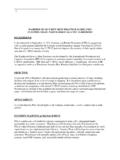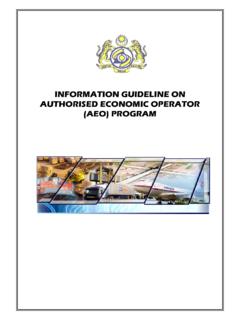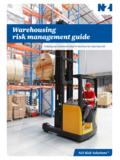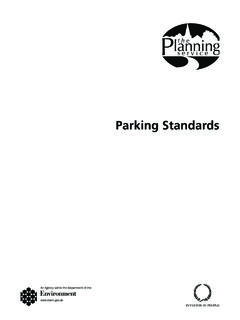Transcription of Annex 9 Model guidance for the storage and …
1 324 World Health OrganizationWHO Technical Report Series, , 2011 Annex 9 Model guidance for the storage and transport of time- and temperature sensitive pharmaceutical productsAbbreviationsBackgroundKey to conventions usedGlossaryIntroductionKey to conventions used1. Port handling and customs Port of entry Offl oading Temporary storage at port of entry Customs clearance2. Warehousing Site Natural hazards Site Site security Site cleanliness3. storage Construction standards Accommodation and layout Loading and receiving Loading bays Receiving Goods assembly and quarantine Goods assembly areas Holding area for incoming goods Quarantine Environmental control of ancillary areas Building General building Controlled and hazardous substances Fire Fire protection equipment Fire prevention, detection and control Building Building cleanliness Pest Power Uninterrupted power supply Power failure contingency Building maintenance4.
2 Temperature-controlled Normative storage capacity of temperature-controlled stores Temperature-controlled storage Temperature-controlled storage for controlled and hazardous products Temperature and humidity control and monitoring in Temperature control Temperature monitoring Humidity control Humidity Alarm Temperature alarms Humidity Qualifi cation of temperature-controlled stores Cleanliness of temperature-controlled stores Refrigeration equipment maintenance Calibration and verifi cation of control and monitoring Calibration of temperature control and monitoring devices Calibration of humidity control and monitoring devices Alarm equipment verifi cation5. Materials Materials handling equipment6. Transport and Normative references Product stability profi les Transport route profi ling and qualifi cation Temperature-controlled Air and sea transport Temperature-controlled road vehicles operated by common Temperature-controlled road vehicles generally Transport of controlled TTSPPs and TTSPPs with high illicit Temperature and humidity control and monitoring during Temperature control in temperature-controlled road vehicles Temperature monitoring in temperature-controlled road vehicles Humidity monitoring in temperature-controlled road Temperature monitoring in passive and active shipping Qualifi cation of temperature-controlled road vehicles Calibration and verifi cation of transport monitoring Calibration of transport temperature control devices Calibration of transport temperature monitoring devices
3 Calibration of transport humidity monitoring devices Verifi cation of transport alarm Shipping Container selection generally Uninsulated containers Qualifi cation of insulated passive containers Qualifi cation of active Shipping container packing Product handling during packing and transport Cleaning road vehicles and transport containers Transport of returned and recalled Transport of returned TTSPPs Transport of recalled TTSPPs7. Normative references Labelling generally Labelling air-freighted shipments8. Stock Stock control General stock control systems and procedures Stock control procedures for controlled and hazardous Incoming Product arrival checks Actions following arrival Outgoing goods (external deliveries) Management of outgoing goods Actions following Product complaint procedures Suspect product Suspect Product return, recall, withdrawal and disposal Return procedures Recall procedures Disposal Traceability or stock tracking9.
4 General procedures and Emergencies and contingency planning General Record-keeping Content of records Record review and Temperature and humidity Temperature records Humidity records10. Environmental Normative references Environmental management of refrigeration equipment11. Quality Normative references Organizational structure Quality Quality system Self inspections Contractors subject to servicel level Management of documents and standard operating Standard operating Document control12. General training Specialist trainingKey referencesFuther readingTask force membership328 AbbreviationsCAPA corrective and preventive action (procedures)DCVMND eveloping Countries Vaccine Manufacturers NetworkEEFO earliest-expiry-fi rst-out. Used in this document as equivalent to FEFO (fi rst to expire-fi rst-out)FIFOfi rst-in-fi rst-outGDPgood distribution practiceGMPgood manufacturing practiceGPSglobal positioning systemGSPgood storage practiceHVAC heating ventilating and air-conditioning (system)IATAI nternational Air Transport AssociationIFPMAI nternational Federation of Pharmaceutical Manufacturers and AssociationsIQinstallation qualifi cationPCCIGP harmaceutical Cold Chain Interest GroupPDAP arenteral Drug AssociationSKUstock-keeping unitSLAservice level agreementSMSshort message serviceSOPstandard operating procedureTTSPP time- and temperature-sensitive pharmaceutical productUPSuninterrupted power supplyUSPU nited States Pharmacopeia BackgroundThese guidelines set out the principal requirements for the safe storage and distribution of time- and temperature-sensitive pharmaceutical products (TTSPPs).
5 They are based upon existing regulations and best practice guidance from a wide range of international sources (see References), while accepting that local legislation and regulations will continue to take precedence. The target audience includes regulators, logisticians and pharmaceutical professionals in industry, government and the international document has been prepared in close consultation with the WHO Task Force on Regulatory Oversight on Pharmaceutical Cold Chain Management which has been central to the review process. A full list of members is given at the end of this intention is that the guidance in this document should be directly applicable in less-developed countries as well as in the industrialized world. To t his end, supplementary materials will be developed to show 329how the requirements can practicably be achieved, particularly in resource-constrained settings. Experience with vaccine supply chain assessments in many less-developed countries demonstrates that the mandatory standards set out in this document can be achieved, and that some countries are also capable of meeting many of the optional document is designed to give a balanced overview of the major aspects of good storage and distribution practice for TTSPPs.
6 As such it deliberately includes references to requirements which can be found in general guides to good manufacturing practice (GMP), good storage practice (GSP) and good distribution practice (GDP). The purpose is not to supplant these source materials, but to ensure that the reader is aware of the relevant GMP, GSP and GDP implications when seen from the particular and specialized perspective of TTSPP management. Key to conventions usedThe following conventions are used in the requirements clauses: The imperative voice is used to denote a mandatory or highly desirable requirement. For example: Ensure , and the like. The words where possible or preferably are used to denote an optional but desirable requirement. Many clauses are followed by a brief explanation setting out the underlying reason for including the clause. GlossaryThe defi nitions given below apply to the terms used in these guidelines. They may have different meanings in other systemsActively powered systems using electricity or other fuel source to maintain a temperature-controlled environment inside an insulated enclosure under thermostatic regulation ( cold rooms, refrigerators, temperature-controlled trucks, refrigerated ocean and air containers).
7 Change controlThe processes and procedures to manage system carrierA seller of distribution or hazardous time- and temperature-sensitive pharmaceutical productsTime- and temperature-sensitive pharmaceutical products (TTSPPs) with high illicit value: poisons, narcotics, psychotropic products, infl ammable or explosive substances and radioactive packing material used to protect TTSPPs from damage during distributionTransport of TTSPPs through various steps in the customer s supply chain ( transport from a pharmaceutical manufacturer s distribution centre to commercial customers (including wholesalers, retailers and buying groups), to clinical facilities or direct to the patient).installation qualifi cationThe process of obtaining and documenting evidence that equipment has been provided and installed in accordance with its specifi cations and that it functions within predetermined limits when operated in accordance with the operating distributionTransport of a TTSPP within a pharmaceutical manufacturer s internal supply chain ( all internal transports from manufacturing facility to packaging facility to warehouse to distribution centre).
8 Net storage capacityThe total volume available for storing TTSPPs, taking account of the type of load support system employed (fl oor-standing pallets, adjustable pallet racking or shelving units), as modifi ed by the utilization factor that can be achieved in the systemsSystems which maintain a temperature-controlled environment inside an insulated enclosure, with or without thermostatic regulation, using a fi nite amount of pre-conditioned coolant in the form of chilled or frozen gel packs, phase change materials, dry ice or birds, bats, rodents and insects whose uncontrolled presence affects hygiene and productAny product intended for human use or veterinary product intended for administration to food-producing animals, presented in its fi nished dosage form, that is subject to control by pharmaceutical legislation in either the exporting or the importing state and includes products for which a prescription is required, products which may be sold to patients without a prescription, biologicals and vaccines.
9 It does not, however, include medical Defi nition from Revision of WHO good distribution practices for pharmaceutical products. In: WHO Expert Committee on Specifi cations for Pharmaceutical Preparations. Forty-fourth , World Health Organization, 2010 (WHO Technical Report Series, No. 957), Annex cationDocumented testing that demonstrates, with a high degree of assurance, that a specifi c process will meet its predetermined acceptance equipmentThe term refrigeration or refrigeration equipment means any equipment whose purpose is to lower air and product temperatures and/or to control relative level agreement (SLA)A service level agreement or contract is a negotiated agreement between the customer and service provider that defi nes the common understanding about materials or service quality specifi cations, responsibilities, guarantees and communication mechanisms. It can either be legally binding, or an information agreement.
10 The SLA may also specify the target and minimum level performance, operation or other service operating procedure (SOP)A set of instructions having the force of a directive, covering those features of operations that lend themselves to a defi nite or standardized procedure without loss of temperatureThe temperature range listed on the TTSPP label, and within the regulatory documentation, for long-term unit temperature/humidity distributionThe range and pattern of temperatures and/or humidity within a temperature-controlled storage unit during normal productA TTSPP whose presentation and/or pharmacological formulation indicates that it has not been manufactured by the company named on the packaging. A TTSPP that shows visible or pharmacological evidence of any environment in which the temperature is actively or passively controlled at a level different from that of the surrounding environment within precise predefi ned excursionAn excursion event in which a TTSPP is exposed to temperatures outside the range(s) prescribed for storage and/or transport.
















